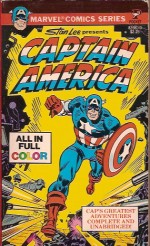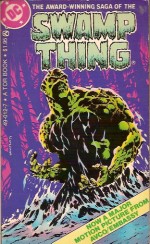
By Stan Lee, Jack Kirby & various (Marvel/Pocket Books)
ISBN: 0-671-82581-X-225
Perhaps I have a tendency to overthink things regarding the world of graphic narrative, but it seems to me that the medium, as much as the message, radically affects the way we interpret our loves and fascinations. Take this pint-sized full-colour treat from 1979.
It’s easy to assume that a quickly resized, repackaged paperback book collection of the early comics extravaganzas was just another Marvel cash-cow in their perennial “flood the marketplace†sales strategy – and maybe it was – but as someone who bought these stories in most of the available formats over the years I have to admit that this version has a charm and attraction all its own…
During the Marvel Renaissance of the early 1960’s Stan Lee & Jack Kirby followed the same path which had worked so tellingly for DC Comics, but with less obviously successful results.
Julie Schwartz had changed the entire comics scene with his revised versions of the company’s Golden Age greats, so it seemed natural to revive those characters who had dominated Timely/Atlas in days past.
A new Human Torch had premiered as part of the revolutionary Fantastic Four, and in the fourth issue of that title the Sub-Mariner resurfaced after a twenty year amnesiac hiatus (everyone concerned had apparently forgotten the first abortive attempt to revive their superhero line in the mid 1950s). All that was left was to complete the triangle by bringing back the Star Spangled Sentinel of Liberty…
However although the teen Torch had won a solo-spot in Strange Tales he hadn’t set the World on fire there (sorry, utterly irresistible and I’m truly ashamed – just not enough to hit “deleteâ€) so it was decided to revive the Company’s biggest Golden Age gun within the fledgling company’s star-packed team-book.
This carefully reformatted digest delight opens with the fabled contents of Avengers #4 (March 1964, inked by George Roussos) an epic landmark wherein ‘Captain America joins the Avengers!’ in a blockbusting tale which had everything which made the company’s early tales so fresh and vital. The majesty of a legendary warrior returned in our time of greatest need: stark tragedy in the loss of his boon companion Bucky, time-lost aliens, gangsters, Sub-Mariner and even wry social commentary all couched in vast amounts of staggering Kirby Action.
Six months later the Old Soldier won his own solo-series in Tales of Suspense #59 (cover-dated November 1964), initially in a series of short, self-contained action romps such as ‘Captain America’, (scripted by Lee and illustrated by the staggeringly perfect team of Jack Kirby & Chic Stone): an unapologetic rocket-paced fight-fest wherein an army of thugs invaded Avengers Mansion since only the one without superpowers was at home…
The next issue held more of the same, when ‘The Army of Assassins Strikes!’, this time attempting to overwhelm the inexhaustible human fighting machine at the behest of arch foe Baron Zemo, whilst ‘The Strength of the Sumo!’ was insufficient when Cap invaded Viet Nam to rescue a captured US airman, after which he took on an entire prison’s population to stop the ‘Break-out in Cell Block 10!’
After these gloriously visceral and bombastic escapades the series took an abrupt turn and began telling tales set in World War II. From ToS #63, March 1965, ‘The Origin of Captain America’, by Lee, Kirby & Frank Ray (AKA veteran artist Frank Giacoia) recounted, recapitulated and expanded the manner in which physical wreck Steve Rogers was selected as the guinea pig for a new super-soldier serum, only to have the genius responsible die in his arms, cut down by a Nazi bullet.
Now forever unique, Rogers became the living, breathing, fighting symbol and guardian of America, but spent his quieter moments as a husky but easygoing ordinary G.I. in boot camp at Fort Lehigh.
It was there he was accidentally unmasked by Camp Mascot Bucky Barnes, who blackmailed the hero into making the boy his sidekick. The next issue kicked off a string of spectacular thrillers as the Red, White and Blue Boys defeated enemy saboteurs Sando and Omar in ‘Among Us, Wreckers Dwell!’ before Chic Stone returned for the next tale ‘The Red Skull Strikes!’ in which the daring duo met and first foiled the Nazi mastermind’s schemes of terror and sabotage in America.
‘The Fantastic Origin of the Red Skull!’ saw the series swing into high gear and switch settings to Europe as sub-plots and characterisation were added to the all-out action and spectacle. With Cap captured by his bragging fascist foe and brainwashed into attacking his own commanders, the Master of Menace felt smug enough to reveal his own rise to power after which ‘Lest Tyranny Triumph!’ and ‘The Sentinel and the Spy!’ (both inked by Giacoia) combined espionage with stunning combat and sinister subversion with mad science as the plot to murder the head of Allied Command segued into a battle with a German infiltrator who had stolen Britain’s latest secret super-weapon.
The heroic duo stayed in England for ‘Midnight in Greymoor Castle!’ (with art by Dick Ayers over Kirby’s) as English and Nazi collaborator scientist Cedric Rawlings captured Bucky whist Ranger Steve Rogers participated on an Army raid in France. The second part ‘If This be Treason!’ had Golden Age veteran and Buck Rogers newspaper strip artist George Tuska perform the same function as the hero deserts his comrades to rush back to Young Ally’s rescue before the final part (and last wartime adventure) ‘When You Lie Down with Dogs…!’ neatly wrapped up the saga, with Joe Sinnott inking a rousing conclusion involving repentant traitors, military madmen and handy terror weapons…
These mini-masterpieces of tension, action and suspense perfectly demonstrated the indomitable nature of this perfect American hero and I suppose in the final reckoning how you come to the material is largely irrelevant as long as you do, but I’m certain that different people are receptive to different modes of transmission and we should endeavour to keep all those avenues open…
© 1979 Marvel Comics Group, a division of Cadence Industries Corporation. All rights reserved.

